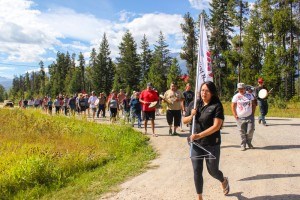
It was an emotional day for many members of the Simpcw First Nation as they commemorated the 100th anniversary of their forced removal from Tête Jaune Cache, B.C.
To mark the occasion, they briefly marched down Blackman Road in Tête Jaune Cache, Aug. 13, before holding a public ceremony to remember those who were forced from their homes by the federal government in 1916.
“One hundred years ago our people were forced to leave their village and walk 300 kilometres or use their horses to go to Chu Chua,” said Simpcw First Nation chief Nathan Matthew.
The Simpcw are part of the Secwepemc, or Shuswap, Nation–one of 17 Bands who historically (and currently) lived in the Thompson River Valley. Their traditional territory extends from north of McLure, B.C. to the headwaters of the Fraser River near McBride, B.C., and from Tête Jeune Cache over to Jasper and south to the headwaters of the Athabasca River. In total, Simpcw territory covers approximately five million hectares of land.
Archaeological surveys have found winter sites and food cache pits throughout the region, including in Tête Jaune Cache and Jasper.
In 1905 the federal reserve commissioner requested a two square mile tract of land be set aside for a reservation for the 70 Simpcw people who lived in the Tête Jaune Cache area at the time. However, in the spring of 1907 the land was sold to a settler and in August of 1916 the Simpcw were ordered by Indian Affairs to relocate to Chu Chua, B.C.
“The attitudes of the non First Nations in those days weren’t very favourable to First Nations to say the least,” said Matthew. “There were petitions to remove the Simpcw people from here and the government listened and the Indian agent from Kamloops with aid of the province police from Prince George came here in 1916 and told the people you have to leave.”
For Jara Jules, a member of the Simpcw First Nation, commemorating her ancestor’s history was a watershed moment in her life.
“You don’t think that coming home to somewhere where you were forcibly removed from is going to be an emotional experience until you’re here,” said Jules.
“I feel whole here. I don’t feel fragmented, out of place, I don’t need to hide. It seems like here is where my spirit feels free.”
Matthew said the band has no plans to have the original plot of land turned over, but it wants the government to return two square miles of crown land near by so they can set up a reserve near Tête Jeune Cache.
“We’ve made the specific claim, but were refused,” said Matthew, explaining the Harper government rejected their land claim in 2006. “The refusal was based on their conclusion that we weren’t permanent residents so there was no necessity to set up a permanent reserve.”
He said he’s hopeful the Liberal government might reconsider their claim, but at this point in time the band has not made a formal application.
At least 25 First Nation groups, Metis and non-treaty groups have historic ties to Jasper National Park, including the Simpcw First Nation. For centuries these groups travelled through the area and lived off the land as hunters, gatherers, trappers and guides.
That all changed in 1910 when Indigenous groups living within JNP were expelled from the park with little or no compensation. The majority of the displaced families, such as the Moberly family, moved to the Grande Cache, Edson and Hinton areas.
In 2006, Parks Canada created the Jasper Aboriginal Forum to address the interests of First Nation groups with historical ties to the park and has invited various groups, such as the Simpcw First Nation, to host ceremonies and celebrations in the park, including this year’s National Aboriginal Day.
A number of dignitaries and representatives attended the commemorative ceremony in Tête Jaune Cache, including Coun. Dwain Wacko and Mark Young, the Indigenous affairs manager for Jasper National Park.
Paul Clarke [email protected]
